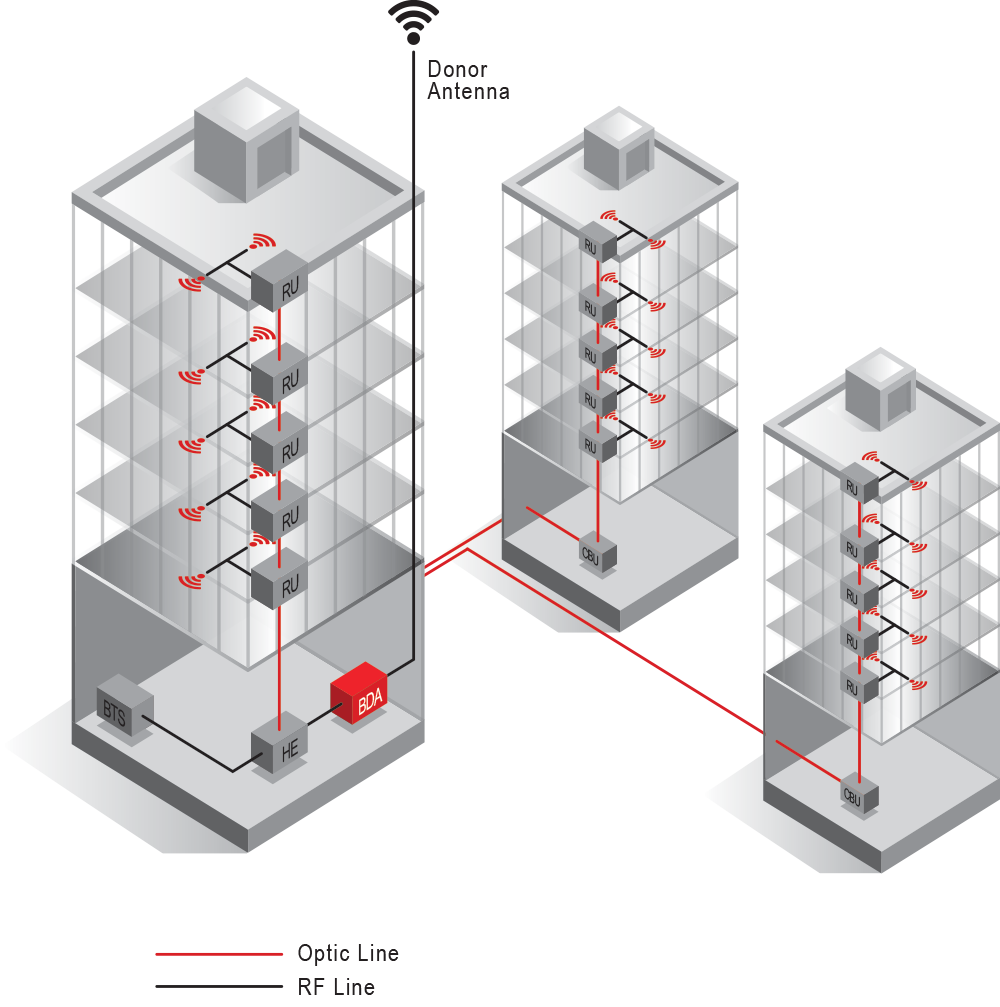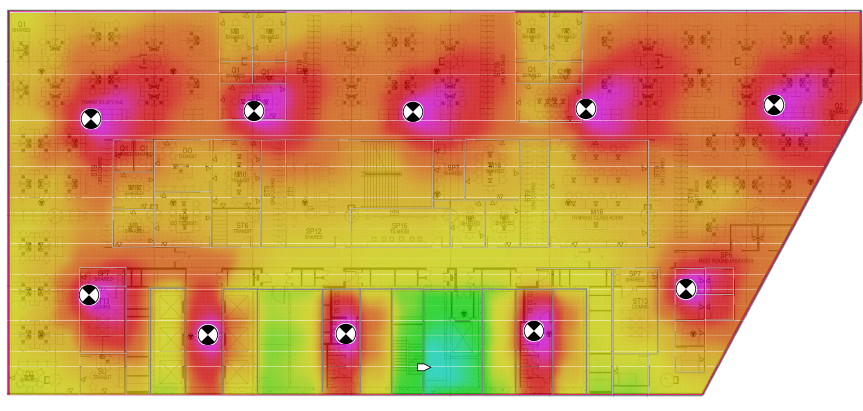DAS stands for Distributed Antenna System, which is a system that allows for the use of cell phones and other wireless devices in areas that do not have direct access to a macro tower or power source. DAS works by receiving power from a radio frequency (RF) source, and distributing it over a system of cables and antennas so that the signal reaches throughout a building or space. Though DAS is relatively new, the need for a DAS is increasing at a rapid rate. Here is an in-depth explanation of the “hows” and “whys” of DAS solutions:

As technology has evolved over time, there has been a shift in how we use our wireless devices. Not too long ago, cell phones were just a convenient communication alternative for when you were outdoors, or away from a building with a landline. Remember when the first mobile phones came out and we called car phone. Now, over 70 percent of mobile phone usage takes place indoors.
Users want to stay connected at all times. Rather than having separate numbers for home, office and travel, they want one phone number they can use at all of their locations, whether it be at home, at the office, or wherever they may be. In addition to this shift, data usage is rising quickly, and is in demand in every location. With the demand for indoor mobile phones and data on the rise, DAS solutions are quickly becoming a necessity for businesses and buildings with coverage challenges.
The types of DAS solutions can be generally classified into three different categories: passive DAS, active DAS, and hybrid DAS. Coupling two DAS solutions together in a larger space is not recommended, because they could interfere with each other. Passive DAS can be used for a smaller area, typically 100 antennas or less, and in a building that does not have a large amount of metal, masonry, or concrete wall materials blocking the RF signals. Passive DAS uses only coax cabling to distribute the signals. It is the smallest, simplest, and often the least expensive DAS solution to implement. Active DAS is a solution used for larger spaces and spaces with more barrier materials that block the RF signals from travelling through the interior space. Active solutions use fiber optic cabling which changes the RF signals into light for distribution, and then back into usable signals at the desired locations. A hybrid DAS solution employs a combination of both active and passive DAS.
Which solution is best for your building? CCE can recommend a customized solution based on the unique communication challenges of your specific location.
Whether a passive, active, or hybrid solution, each DAS system will consist of certain basic components. The first component is the donor antenna, which is usually located outdoors and above the tree line to directly receive RF signals from a macro tower or signal source. The donor antenna can receive multiple frequencies to meet emergency and large capacity needs. Once the signals are received by the donor antenna, they are transported to the head-end equipment room via coax cabling. If the donor antenna is the eyes and ears of the DAS solution, the head-end equipment room is like the brain of the system. This is where the repeater, base station or bidirectional amplifier, collects the RF signals for redistribution. The bidirectional amplifier is a very important component in a DAS solution. Without it, the RF signals would continue to grow weaker as they travel a farther distance from the donor antenna. With the bidirectional amplifier, the signal is increased, or amplified, as it travels, so that the RF signal stays strong throughout the system and site.
Depending on the type of system, the signals are transported via coax or fiber optic cables to remote antennas. These remote antennas are compact, and can be placed discretely in an indoor environment. Sometimes called antenna nodes, these antennas are the redistribution points of the DAS network. With the aid of the remote antennas, the RF signals are distributed to places they could not directly reach without the distributed antenna system. Though each DAS solution has common components, it will be built to overcome the specific communication challenges in a particular location.
When the expert DAS implementation team at CCE builds a solution for a client, the team will first perform a site survey to gather preliminary information about the location and specific coverage needs. This site survey includes floor plan details such as public vs. private areas, and identifies all areas in need of coverage if the solution will be built for just part of a building. The team will gather information regarding the building’s construction materials (plasterboard, concrete, metal, etc.) which will affect a signal’s ability to travel.
With preliminary information gathered, the implementation team evaluates the RF reception in each area, determines the locations for each component of the system, and plans the cable routes. In addition, the team considers the security needs of the DAS solution. Performing a detailed site survey will ensure that each component of the system is chosen and placed for successful communication in all targeted areas.

With the MCF 2018 guidlines, the new fire codes suggested RF coverage guidelines to ensure that first responders have constant radio communication. The suggestions included providing RF signal strength in 95% of all building areas. To ensure better coverage for public, CCE will provide assurance and guidance in your systems need that meet all code requirements for your area.
There are many benefits to installing a DAS solution in your building. When you weigh the cost and benefits, DAS should be a high priority in coverage challenged locations. Here are some of the main benefits you can expect from DAS:
With the demand for mobile phone and data service everywhere, as well the need for reliable communication during emergency situations, the need for a DAS solution in a coverage challenged location is fast becoming a necessity. Applications for DAS solutions include a wide variety of locations, such as hospitals, casinos, transits, stadiums, universities, convention centres, and office buildings. Any location where people want the convenience and safety of reliable communication is a candidate for DAS.
Strengthen your business by eliminating weak mobile phone and wireless signals. CCE helps you dramatically improve mobile phone reception by installing a state-of-the-art distributed antenna system (DAS) inside your building. As a business professional, you do not want dropped calls or bad cell phone reception. Reliable mobile phone coverage is absolutely essential in emergency situations. Contact our DAS installation experts for design services and consultations when you need a distributed antenna system installed in your building. We serve commercial clients throughout Australia, including Queensland New South Wales, Victoria and Tasmania. Some of our partners
By providing distributed antenna systems installation, we improve the safety of those on universities, hospitals, and areas of poor mobile phone reception. Our equipment of active repeaters, splitters, and feeders optimized buildings and areas to ensure a dependable signal.
Your DAS design will need to meet the system coverage requirements of both the MCF 2018 GUIDELINES. While MCF indicates that 95% coverage is needed in all areas. While areas that are being used during the day are usually covered in a DAS design, these aren’t always the areas where emergency responders are during a crisis. For instance, fire responders aren’t always in the office, the break room, or conference room. Many times they’re trying to get to hard-to-reach and uncommon places such as equipment rooms, basements, stairwells and elevators to gain access to the emergency phone.
Implementing these minimum coverage standards into your next DAS project requires more effort and a closer look at your materials and the final design. You’ll also need to take advantage of a comprehensive initial radio frequency (RF) survey. Consider the radio frequencies used by local public safety personnel when it comes to your DAS coverage as well as the building’s location and layout in order to ensure coverage will be adequate.
CCE has a distributed antenna solution for you. We provide DAS design and consultation services that improve wireless frequency coverage for any location. Whether you are located in a stadium, hospital, hotel, or large building, we ensure you always have wireless, voice, and data coverage. As a business owner or a consumer, you expect your mobile phone to work anytime and everywhere. Our distributed antenna systems products expand wireless mobility inside, allowing work to be done anywhere. Best of all, we provide DAS design, custom DAS engineering, and comprehensive installation services for customer nationwide.
A mobile repeater, or a bi-directional amplifier, boosts mobile phones signals through antennas and amplifiers. You’re never too far away from our DAS antennas because we install them throughout your building or location. The DAS consulting team CCE provides free phone consultations to achieve the clients needs. Using a state-of-the-art mobile repeater as a phone signal booster, you can expect consistent reception regardless of your location.
Since 1997, our team of highly skilled designers and installers have served clients throughout Australia. We offer premium products, such as signal boosters and mobile repeaters. Most importantly, we provide turnkey solutions for your wireless enhancement needs. Whether you need installation or distributed antenna systems, we are here to serve your needs.